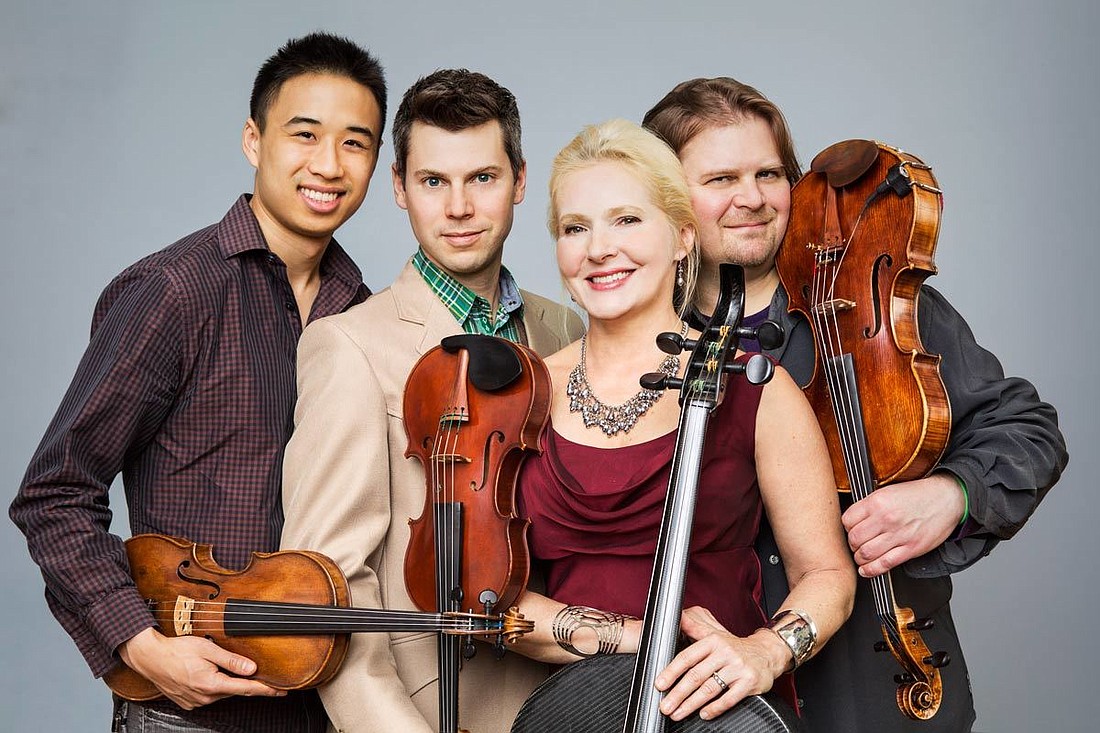- November 23, 2024
-
-
Loading

Loading

Smiling clowns dressed in vibrant polka dots are clomping around in oversized shoes. Breathtaking trapeze artists are flying through the air as if there are wings beneath their costumes. And the sound of the calliope beckons anyone in the vicinity to join in.
What if you could enter this world by simply taking a seat inside the Historic Asolo Theater?
That’s the goal of Ethel, a traveling string quartet specializing in original, modern compositions that will premiere its latest production, “Circus: Wandering City,” on Jan. 26 at The Ringling.
“It’s been an amazing experience for us to immerse ourselves in their collection and educate ourselves on the history of circus and the personas embodied in the imagery,” says Ethel Artistic Director Dorothy Lawson.
Ethel formed in New York City 20 years ago as a group of classically trained musicians with a taste for contemporary music, Lawson says. Now, Ethel members travel the U.S. performing pieces either written by them or for them, aiming to transcend stylistic distinction.
In 2013, the group created a multimedia show called “Documerica” that featured images from the archives of the Environmental Protection Agency.
Ethel performed “Documerica” at The Ringling during its national tour in 2015, and the group caught the attention of Dwight Currie, curator of performance at The Ringling.
He asked Ethel to consider a collaboration with an idea similar to that of “Documerica”: combining images and videos from the museum’s archives with live music to tell the story of several circus heroes.
“It’s a beautiful tribute to these historical images and brings them to life in a different way,” Lawson says.
During the process of creating the show, the four musicians flew to Sarasota to take a tour of the museum’s archives. There, Lawson says they were introduced to Deborah Walk, curator of historical documents, who gave an overview of the 80-some years’ worth of materials in the collection.
Walk offered Ethel materials that had already been transferred to a digital format and were therefore usable in the commissioned multimedia performance. The group’s video designer picked the material its members found most compelling and developed the show’s visuals around that.
Lawson says showcasing the photos, performance clips and living histories (performer interviews) from the museum’s archives is the best way to tell the story of the circus — particularly when music is added.
“People share music in video form all the time and experience music with movies and TV, and our brains are so comfortable and accustomed to this sort of enriched level of stimulus,” she says.
After the group was given materials from the archives, members chose a series of themes such as heroism, courage and wonder that the imagery inspired. They developed a storyboard and wrote music based on that plan and sampling of images.
The end result is an energetic, sensory performance with music inspired by the sounds of the circus, Lawson says. She adds that the experience will be very similar to listening to a film score and less like listening to traditional string instrumentation.
Lawson says this performance is more important than ever in light of the closing in May of the Ringling Bros. and Barnum & Bailey Circus. The circus brought a sense of wonder to Americans who needed it, she says, and it’s inspiring to relate to these giant themes that make up the human experience.
Just like the traveling circus brought the world to the hometowns of Americans who didn’t have access to travel, this traveling performance will bring an uplifting experience to people around the country, regardless of their background, she says.
“It’s what we do. We regard our concerts as pieces of art to bring to as far and wide as possible,” she says.